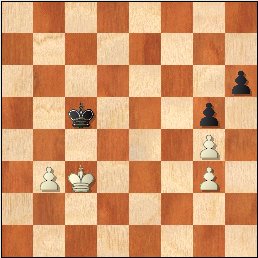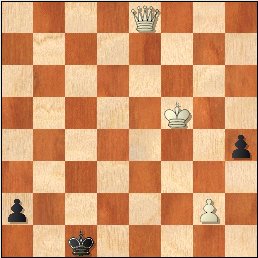

Improve your Chess via Active Learning
ACTIVE LEARNING is any strategy that involves students in doing things and thinking about the things they are doing (*)
You could study the following material either by skipping the test and going directly to the lecture. Or start by attempting to figure out on your own what is going on in each of the positions I will be talking about and then proceed to the lecture. If you chose the latter, spend time on each diagram and record your evaluation and move / plan for the side whose turn it is and sample variations. Then compare your ideas with mine. Let me know how you like the test and the lecture
Test yourself:
Level - beginner through advanced.
1. Check whose move it is / Read the question.
2. Evaluate position (i.e. White is Better, or Black is Winning, or Equal...)
3. Find the Best move and, if necessary, support it with variations. <<CALCULATE thoroughly!!>>
4. Answer the question (if there is a specific one)
 |
 |
| #1. White to Move. What result do you expect? What should be White's strategy? Black's strategy? | #2. White to Move. What result do you expect? What should be White's strategy? Black's strategy? |
STOP - Lecture begins below.
Enjoyable Efficiency – Two Simple Winning Ideas You Must Know, Especially When Playing Speed Chess.
This article was written for the website http://www.chess.com/ in February 2009.
Professionals focus on achieving the victory in every game, while amateurs usually happy to enjoy the process, where the victory is a bonus. Mostly, the amateurs can only find time for speed chess. When I was growing up, 5 minutes per game for each player (G5) was the staple of the speed chess. These days, especially on-line, it looks like G3 is one of the favorite time controls.
First of all, I must emphasize that, in my opinion, playing speed chess is detrimental to anyone who is seriously trying to raise his/her game level. I always tell this to my students who have high aspirations. Having said that, I know that many recreational players enjoy this competition. I'm among them and play G3 chess on ICC from time to time.
One of the worst feelings I’ve experienced during these games is when I have a won Pawn endgame, often get a Queen and have one or two moves before the checkmate, yet only have seconds left, ultimately running out of time. This is especially annoying when my opponent has one helpless pawn left, hereby getting a victory (if he had no pieces left and I run out of time the game is a Draw).
I am here to share with you 2 very interesting winning ideas I’ve developed over time that are very useful in any chess game, but especially come handy in the sudden death time control with just a few seconds left.
Not only these ideas are simple and successful, but they are also elegant and efficient, thus giving you an increased moral satisfaction in addition to the full point.
The 1st situation –
A pawn endgame. You have an outside pass pawn. You either have an extra pawn, or it is a balanced position, with your opponent’s pawns on the other side immobilized, but not without a legal move. For example (from a game on ICC):
|
Diagram #1 White or Black to move |
White is easily winning here, no matter whose move it is. Black's strategy is defend against the b-pawn.
While the K-side seem to be "frozen" at the moment, White can't simply promote his b-pawn as K+P vs. K endgame is a drawn one with a proper defense. (Remove all pawns on the K-side and practice against a friend or a computer if this statement was surprising to you)
The common strategy for White is called "the outside pass-pawn strategy" - whereby White uses the b-pawn as a decoy. While the Black King wins it, the White King goes to the K-side, gobbles the pawns and transposes into a won pawn endgame. (Practice against a friend or a computer if this strategy wasn't clear to you).
"The outside pass-pawn strategy" is a must-know. It has a wide applicability and usually a sure winner, but it would take good 11-12 moves just to get the Queen and then another several moves to make a checkmate. Often you don't have the time in the sudden death time control (games on all levels, but especially blitz) |
|
Well, I invite you to meet my favorite strategy - White simply pretends that the K-side pawns don't exist and start advancing the b-pawn. With the best defense, Black is able to reach the position on the diagram 1a and White's turn to move. Now, without the K-side pawns, White must give up the b-pawn or play Kb6 with the stalemate. However, we do have the pawns on the K-side and, if need be, Black has a 'suicidal' move there - Ph6-h5. All White needs to do therefore, is to play 2. Kb6, forcing Black to play 2...Ph5. After 3. Pxh5 Pg4 4. Kc6! (4. Ph6?? stalemate) Ka7 5. Kc7 Ka6 6. Pb8Q, White wins. Even more fun would have been without the White Pg3, where, after 3...Pg4, White could simply advanced the h-pawn all the way to h8 with checkmate!
Note - before deciding to utilize this strategy not only you need to confirm that your opponent will have at least one legal pawn move, but also that, after your planned response, he would have another move. For example, if in the diagram 1a, we remove the pawn h6 and move the White g-pawns to h2 and h3. Now, White can’t implement the ‘stalemate’ strategy as after 2. Kb6 Pg4 3. Ph4 (3. Pxg4 stalemate) Pg3! 4. Pxg3 stalemate . Even worse is 4. Ph3, as the Black g-pawn will Queen first. (Practice against a friend or a computer if this explanation wasn't clear to you) |
Diagram #1a White to move (after 1. Pb6-b7+ Kc8-b8) |
The 2nd situation –
You have a Queen and your opponent has a rook pawn on the 7th rank. There are other pawns on the board. Your turn to move. For example (from a game on ICC):
|
Diagram #2 White to move |
White is easily winning here, no matter whose move it is. Black's strategy is to promote the a-pawn
White has at least 3 winning strategies here: (a) A simple one, applicable in many similar endgames - gain control over the a1-square with the Queen (say after 1. Qa8) then send the K to win the Black pawns. When the new Black Queen arrives (after 1...Kb1 and 2...Pa1Q), White will give up his Queen, then promote his g-pawn.
(b) a tactical one, where White doesn't even use his K to win the h-pawn - 1. Qh8 Kb1 2. Qxh4! Pa1Q 3. Qh1+, then 4. Qxa1 and promoting the g-pawn.
(c) Finally, my favorite one - White pretends that the pawns other than the a-pawn don't exist and begin assault of the a-pawn. You should know that White can't simply win this a-pawn without the help of his King, which is too far in this example. The particular endgame of K+Q vs. K+Pa2 is a drawn one with the good defense. (Remove all pawns on the K-side and practice against a friend or a computer if this statement was surprising to you) |
|
However, the presence of the single Black pawn that can move makes all the difference. White can easily reach the position in the diagram 2a. Black plays 1...Ka1, which, without the K-side pawns, would be sufficient for a draw, but here White has a sneaky 2. Qc2!! Ph3 (nothing else) 3. Qc1#
Note - the (c) strategy should work all the time, as long as the other side has a pawn move, while the other two strategies may fail or just be less efficient. (a) strategy may not work if Black has many pawns on the K-side. (b)-strategy is based on a concrete tactics and usually require a specific setup (skewer) present. |
Diagram #2a Black to move (after 1. Qc3-b3+) |
Summary:
I showed you two ideas that I commonly employ when the situation permits. Not only I find them efficient, but also ENJOYABLE to execute!
The list can be easily expanded with some small modifications and I welcome you to try and let me know what you find. I developed these ideas on my own by extrapolating from the tricky example I learned over the years, mainly from the studies (specially designed endgame positions). Hence, I believe that one of the best way to learn new ideas and expand your endgame skills is by solving studies. You can find them scattered in the regular endgame books, or pick a collection in a single book. I always like to carry around with me a little thin pocket book with 100 studies by Kubell, Troitsky or Rink. They are cheap and entertaining, but somewhat difficult too. You should study them with the chessboard.
==============================================================================================
What do you think about this article? How did you do? For comments,
corrections send email or use
this
form
More on chess training (serious and enlightening) in my books:
|
|
Chess Exam and Training Guide (2004) $24.95 + shipping Chess Exam and Training Guide: Tactics (2007) $19.95 + shipping CE + CE Tactics (Holiday Special! Free chess cartoon calendar $8, while supplies last) - $39.95 - insured shipping in US is included |
Copyrighted @ 2009 Igor Khmelnitsky
For comments or permission to reprint please send inquires via email or this form
This article was written for the website http://www.chess.com/ in February 2009.
(*Bonwell, C., & Eison, J. (1991). Active learning: Creating excitement in the classroom (ASHE-ERIC Higher Education Report No. 1). Washington, DC: George Washington University, p. 2)